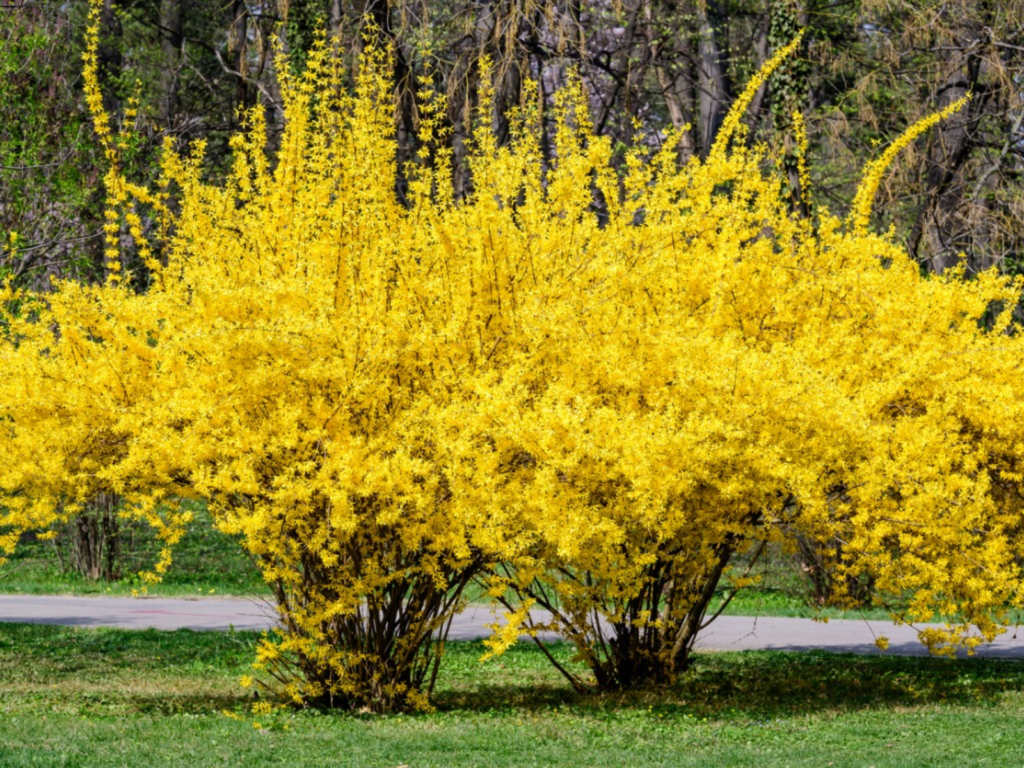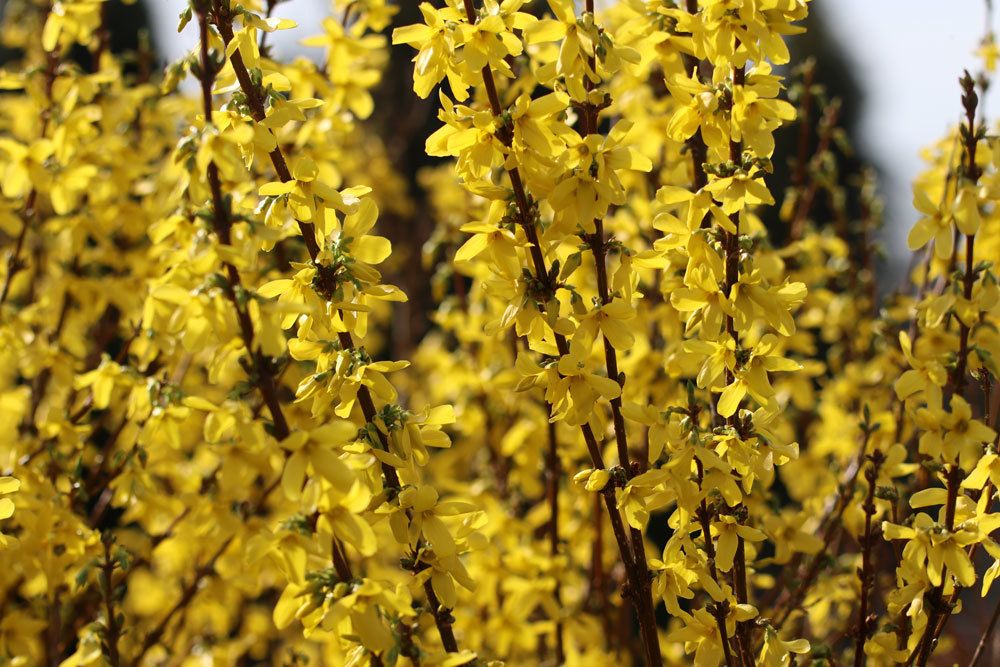Forsythia is a popular ornamental shrub, which with its bright yellow flowers in March is one of the first harbingers of spring. The flowering branches of the forsythia decorate many homes during the Easter season and are often hung with colorful eggs. This draws the interest of many young children to the beautiful forsythia branches, which seem to herald warmer days with their sunny yellow color.
Often warned against planting forsythia, because they are poisonous. This is only partly true. It is true that the pretty ornamental shrubs contain small amounts of incompatible substances. However, to cause serious damage, humans would have to consume larger quantities.
Contents
Forsythia
But it is often reported that the yellow flowering branches are very poisonous and could be dangerous for children. This is a widespread misconception. It stems from the fact that many people believe that forsythia and laburnum are one and the same plant. However, in fact, forsythia has the epithet goldilocks, while laburnum is a completely different plant. Laburnum is highly poisonous. Its poison is particularly highly concentrated in the seeds. But what about the forsythia? Here, concerned parents and pet owners can find out whether this plant can also be a danger to children or pets, or whether it is safe to decorate gardens and homes with it.
Origin
European garden forsythia is a species of Asian forsythia cultivated in temperate climates with the botanical name Forsythia. Native to China, it is popular in our latitudes as an ornamental shrub. It is also known as golden bell or golden lilac. Together with other ornamental shrubs and flowering plants, it decorates borders and lawns. If a garden was designed before a child, dog or cat completed the family, it should be checked once again whether among the existing colorful and decorative plants and shrubs are those that could be dangerous to the health and well-being of children and pets. Also, is the popular golden lilac among the plants of concern that should be replaced, or can the whole family enjoy it?
Toxicity
Factors that determine whether the forsythia is poisonous or harmless.
Saponins and other glycosides are found in the various plant parts of goldenseal. However, saponins are also among the ingredients of numerous vegetable plants such as spinach, tomatoes or peas. They are harmless to humans but incompatible with some animal species. However, this does not apply to pets such as dogs and cats, so they can be kept in gardens decorated with goldenseal without hesitation. Animals for which the substances the plant contains could be dangerous are birds and insects. They stay away from the laburnum. Its flowers contain glycosides as well as various essential oils.
Parts of the plant
Suitable for the garden due to the insignificance of toxicity.
The scientific answer to whether goldenseal is dangerous to children’s lives is: no. The plant is poisonous to a small degree. This applies to all of its parts. The toxicity is so low that goldbells are wonderful for a family garden, as they are harmless to young children as well as pets. In addition, their beautiful sight is an asset to the home paradise.
Toxins
When to be cautious and which parts of the plant are affected.
Goldbell is mildly toxic In the leaves, fruits, and seeds, as there are saponins and glycosides in all of these parts. The yellow flowers also contain glycosides and essential oils. It is not known after eating what amount of plant parts of goldenseal will cause discomfort. Possible symptoms of poisoning after ingestion of large amounts of seeds, fruits, leaves or flowers are malaise with nausea, abdominal pain and possibly diarrhea.

Poison effect
The effect of the herbal ingredients
Eating large amounts of seeds, fruits, leaves or flowers could cause malaise with nausea, abdominal pain and possibly diarrhea. Flavonoids such as rutin and quercetin are found in the flowers of the plant. Rutin is known in herbal medicine as an important active ingredient for the relief of venous disorders (venous edema). However, it is usually used with buckwheat herb, since goldenseal has only a small amount of the active ingredient.
The yellow forsythia is the epitome of freshly blooming spring and is one of the most popular ornamental shrubs. It is therefore all the more surprising that the claim that forsythia are poisonous is made time and again. Is that really true?
The good news is that forsythia cannot poison you. At worst, they are slightly poisonous. But who would eat the ornamental shrub? Even young children are more likely to snack on the tempting cherry-like daphne fruits than the flowers or leaves of forsythia. The greater danger is confusing the non-toxic forsythia with poisonous species.
Are forsythias poisonous?
Forsythia do contain some substances that can cause digestive disorders – but it would be an exaggeration to classify forsythia as poisonous. In traditional Chinese medicine, the shrubs have even been used as medicinal plants. A greater danger is to confuse the non-toxic forsythia with highly toxic plants such as broom.
Confusion of forsythia with poisonous plants.
Poisonous butterfly plants such as broom (Cytisus) and laburnum (Laburnum) also bear yellow flowers, but are not quite as early as forsythia. Forsythia is also known by the name goldenseal, which sounds similar to laburnum. Goldenseal, like many legumes, contains toxic cytisine, which can cause death in children in doses as low as three to four pods. Most cases of poisoning occurred in preschool-age children who played with and ate the bean-like fruits and seeds in the garden.
Risk of poisoning from forsythia extremely low
Consumption of small amounts can lead to mild poisoning in young children at most. After consumption of plant parts of forsythia, vomiting, diarrhea, and abdominal pain were reported in isolated cases. The symptoms disappeared spontaneously and did not require any further therapy. Therefore, in the opinion of the authors, forsythia can be planted even in kindergartens or similar institutions. As a preventive measure, however, children should be taught that ornamental plants in general can be dangerous and are not suitable for eating. The old Paracelsus wisdom “the dose makes the poison” applies.
Forsythia contains saponins and glycosides in leaves, fruits and seeds. Saponins can have an irritating effect on the stomach and intestinal mucosa. Normally, these substances are largely harmless to humans. There is also hardly any danger for dogs and cats – especially since these animals have a more or less good instinct by nature as to which plant they may and may not eat.
Forsythia wild species as a medicinal plant.
In traditional Chinese medicine (TCM), the forsythia is even an ancient medicinal plant. It is the wild species Forsythia suspensa. Its fruits are used for detoxification in bacterial infections and to reduce fever.

Prevention
Tips & Tricks
Children should be warned against eating the plant. Parents can point out to them that they should not be tempted by the golden yellow color of the flowers to eat them. In general, it is advisable to teach children never to swallow parts of plants they do not know. In this way, it is possible to exclude the possibility of stomach upset or other mild symptoms of poisoning. If, however, despite all caution, young children do experience discomfort after eating large amounts of plant parts, giving them liquids such as water and tea can alleviate them and make them subside altogether. Giving ripe bananas or eating bitter chocolate can also be helpful if stomach upset with diarrhea has occurred.


